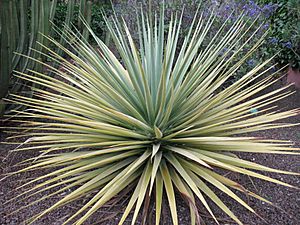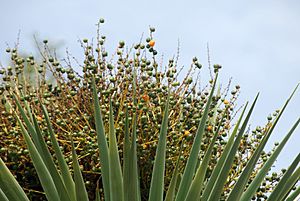Drago de Gran Canaria facts for kids
Quick facts for kids Drago de Gran Canaria |
|
|---|---|
 |
|
| Conservation status | |
| Scientific classification | |
| Genus: |
Dracaena
|
| Species: |
tamaranae
|
Dracaena tamaranae, also known as the Gran Canaria dragon tree, is a special plant found only on the island of Gran Canaria. It's a relative of the famous dragon tree, Dracaena draco, and other similar plants from East Africa.
For a long time, people thought these trees on Gran Canaria were just regular Dracaena draco. But after careful study, scientists realized they were a unique species. It was officially named and described in 1998 by F. Marrero, A. Almeida, and M. Gonzáles-Martín.
Contents
What Does the Gran Canaria Dragon Tree Look Like?
This dragon tree has stiff, ribbed leaves. They are pointed at the end and have a bluish-gray color. This color is different from the green leaves of D. draco.
The tree doesn't grow as bushy or spread out as much. It can reach over 8 meters (about 26 feet) tall. Its bark is yellowish-gray and a bit shiny. The flowers are whitish-green. They grow in a branched cluster up to 80–100 cm (about 3 feet) long. The seeds are round and slightly flat. They are about 6–7 mm (about 0.25 inches) wide.
This plant looks similar to other Dracaena species. These include Dracaena ombet and Dracaena schizantha from East Africa. It also looks like Dracaena serrulata from Arabia. Scientists think this species might have arrived in the Canary Islands millions of years ago. This would have been during the Miocene period.
How Is It Different from Other Dragon Trees?
The Gran Canaria dragon tree has some key differences from Dracaena draco:
- Its leaves are ribbed and more bluish-gray. This is true even for young plants.
- Its flower clusters are more branched.
- The flowers themselves have different features.
- Its fruits and seeds are smaller.
- It is most similar to species from East Africa and Arabia. D. draco is more like the dragon tree from Socotra Island. Socotra is in the Indian Ocean.
Where Does the Gran Canaria Dragon Tree Live?
These dragon trees are found in the southern part of Gran Canaria. This area is drier than where Dracaena draco usually grows.
The Gran Canaria dragon tree likes dry, warm areas. It lives in places that get between 200 and 500 mm (8 to 20 inches) of rain each year. The trees are found in the oldest parts of the island. They often grow on cliffs that are hard to reach. These areas still have parts of their original plant life. This includes juniper trees and rockrose bushes. The dragon tree grows alongside plants like junipers, wild olive trees, and pines.
This special tree is in danger of disappearing. It is listed as a threatened species. Because of this, it needs a plan to help it recover and survive.
Growing This Tree
It is hard to grow this tree outside of scientific studies. This is because there are so few of them left. Experts suggest not planting D. draco in areas where the Gran Canaria dragon tree might grow. This helps protect the unique species.
About Its Name
The scientific name Dracaena tamaranae was first published in 1998. It was described by Marrero Rodr., R.S.Almeida, and Gonz.-Mart. The information was shared in the Botanical Journal of the Linnean Society.
What Does "Tamaranae" Mean?
The name Dracaena comes from an old Greek word meaning "female dragon." The word tamaranae is linked to Tamarán. This was an old name for Gran Canaria used by the island's first people.
See also
 In Spanish: Dracaena tamaranae para niños
In Spanish: Dracaena tamaranae para niños



